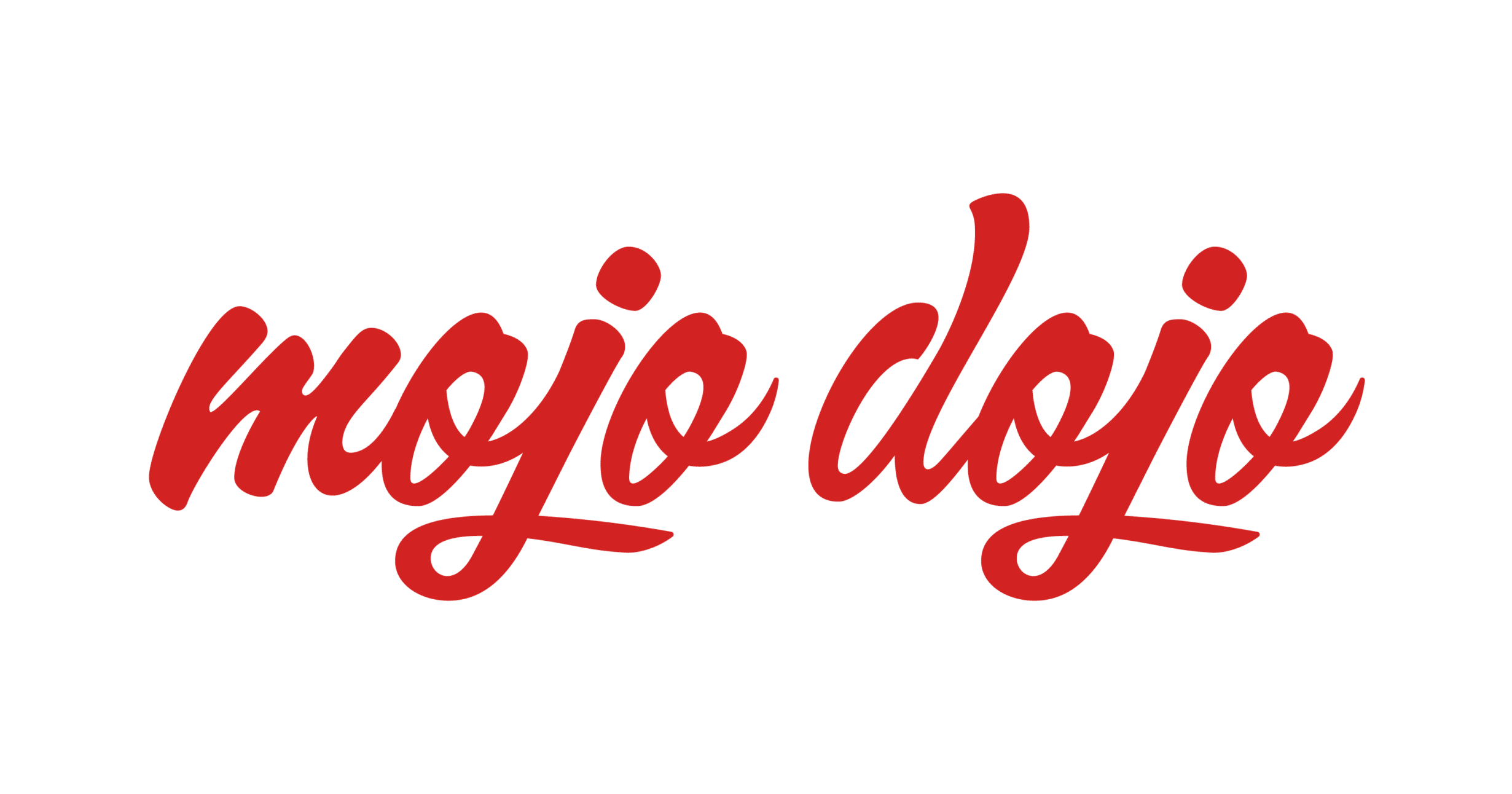You’ve created a brand and are ready to start selling your products or services.
The next step is to find and convert potential customers. But creating a website and posting to social media is not enough (in most cases).
Getting your business launched is exciting, but the excitement is often short-lived. Many new companies fail to get to the next step of acquiring and growing their sales.
Without a clear strategy for how you will gain traction, it can feel like you’re drowning amongst your competitors.
Gabriel Weinberg, one author of the book ‘Traction, outlined 19 channels of traction.
These are marketing channels that can be used to generate sales and gain traction.
By testing each one, you can find the ones that work for your brand. And in doing so, hone in on these and increase your chances of success.
We’ve outlined each channel below in detail to give you an idea of how to use each one.
Viral Marketing
The more you can spread the word about your products or services the better, right?
Well, that’s how viral marketing works. It’s when a message spreads exponentially between individuals.
The aim is simple. To encourage individuals to promote your message to friends, family, and networks.
This generates excitement and hype, making people want to know more. The more viral it goes, the more your message spreads and the more results you’ll see!
Some examples of viral marketing are:
- The ALS ice-bucket challenge
- Melbourne Metro Trains “Dumb Ways to Die” Campaign.
The digital environment has increased the ability for content to go viral. Social media makes it easy for individuals to share content, experiences, and opinions.
Websites and blogs are also great places to publish content for people to share.
Businesses can tap into these resources to spread their message far and wide.
When the positioning is right, you can help to trigger this process. It all comes down to the message you’re sharing, the ‘messengers’, and the environment in which you are sharing.
This is known as intentional or deliberate viral marketing.
This technique is a great way to educate and promote a product or brand in a fast and cost-effective way.
However, we’ve warned you! Content can go viral for the wrong reasons – referred to as accidental viral marketing.
This can create negative press and damage your brand.
Public Relations
Public relations is the planning and deliberate dissemination of information to the public.
It differs from standard PR, as you are in control (to an extent) of the circulation of information.
There are so many advantages that come from good PR:
- Increase your brand’s credibility in the public eye
- Attract and engage with your target audience
- Build your brand image and reputation
- Improved SEO
There are traditional media avenues such as news outlets, magazines, and print publications.
But the net now casts further to include bloggers, podcasters, and YouTubers.
You can use these avenues to manage how individuals see and feel about your brand.
Ways in which you can use public relations in your business could include:
- Submitting press releases to news outlets
- Sharing press releases on your social media accounts
- Interviews with journalists, bloggers, or other content creators
- Guest appearances on podcasts
- Damage control if your brand receives negative press
- Below is an example of a press release from Porsche promoting a new electric powertrain.
Below is an example of a press release from Porsche promoting a new electric powertrain.
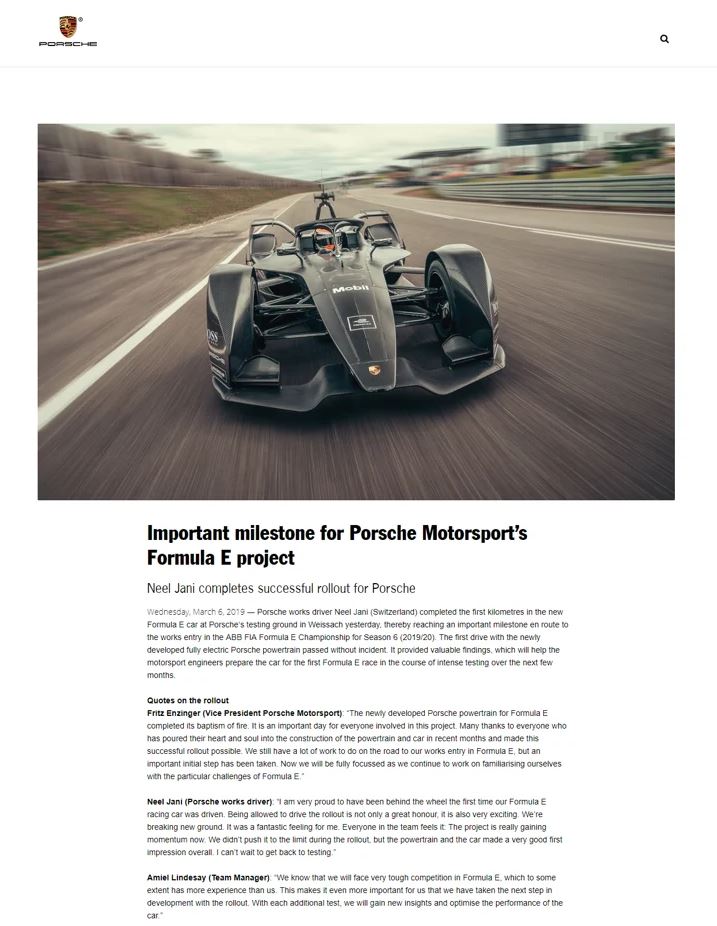
Whether you manage your PR internally or use an external provider is up to you.
But either way, PR is essential to helping your brand reach success.
Unconventional PR
In a world with so much content available at our fingertips, it can be hard to stand out.
One way to break through the noise is with the use of unconventional PR tactics.
Unconventional PR differs from ‘standard’ PR.
It uses unexpected or abnormal methods to bring publicity to your brand.
It’s all about breaking the rules to get people’s attention. Using tactics and campaigns that go against the grain and are viewed as unusual.
Some well-known examples of unconventional PR are:
KFC – Advert visible from space
In 2016, KFC created an advertisement that was visible from space (albeit, not in person).
For such a well-known, established fast-food outlet, it can be hard to stay relevant. This use of unconventional PR created press coverage and boosted brand awareness.
McDonalds – International Women’s Day
The company showed its support for International Women’s Day in 2019 by flipping it’s logo upside down (an M to a W).
It gained a lot of press, both positive and negative. Some appreciated their support, while others thought it overlooked the deeper meaning behind the day.
Virgin Airlines – Hot Air Balloon around the world
This campaign involved Richard Branson attempting to make it around the world. But, not in a plane. In a Hot Air Balloon.
Not only was it fascinating and intriguing, but the stunt also ended with a crash. This created a huge amount of press coverage for the company all around the world.
With unconventional PR, it doesn’t necessarily matter if the publicity you receive is negative.
As long as you achieve publicity, it’s viewed as a success. If it gets people talking and coming through to your site, it’s likely you’ll generate more leads and sales.
So, be warned! Unconventional PR can backfire. But it can also provide great results if you hit the mark.
Search Engine Optimisation – SEO
Approx 68% of online experiences begin with a search engine.
If your website isn’t appearing in Search Engine Results Pages (SERPs), then you’ll struggle to get found.
Search Engine Optimisation is a way for you to combat this, organically.
You’ll be able to increase your visibility and chance of appearing in search results, for little cost.
Google processes over 8.5 billion searches per day.
And, with 1.14 billion websites online, how does Google know what results to show? It uses algorithms, that’s how. And this is where your ranking comes into play.
There are many factors that determine your ranking.
Some of which are still a mystery. But the key components are technical optimisation, on-page optimisation, and off-page optimisation.
Technical Optimisation
- The technical setup of your website.
- Is what the search engine ‘spider’s or ‘bots’ crawl and use to index your site
- Your site architecture/maps, site speed, 404 pages, and 301 redirects.
On-page Optimisation
- The things within your page content on your website.
- The keywords, phrases, and use of elements such as the correct headings, title tags, and metadata.
- The more relevant and aligned these are with search intent, the better.
Off-page Optimisation
- Refers to all the measures you can take outside of your website.
- One of the major components of off-page optimisation is backlinks.
- The more high-quality backlinks you can have, the higher your ranking will be.
- Links to your website from (trusted) third-party websites, social media, and podcasts.
- Helps to show search engines your content is relevant, authoritative, and trustworthy.
Search Engine Marketing – SEM
The other option to increase your chances of appearing in SERPs is to use SEM (Search Engine Marketing).
This is where you pay to have ads appear in SERPs, driving traffic to your website.
With Pay Per Click ads generating twice the visitors than SEO does, this is a great way to achieve results, fast.
You can brand in front of people actively searching for relevant, specific keywords and phrases.
In 2020, Google’s ad revenue was $146.92 billion and 63% of people have clicked on a Google Ad.
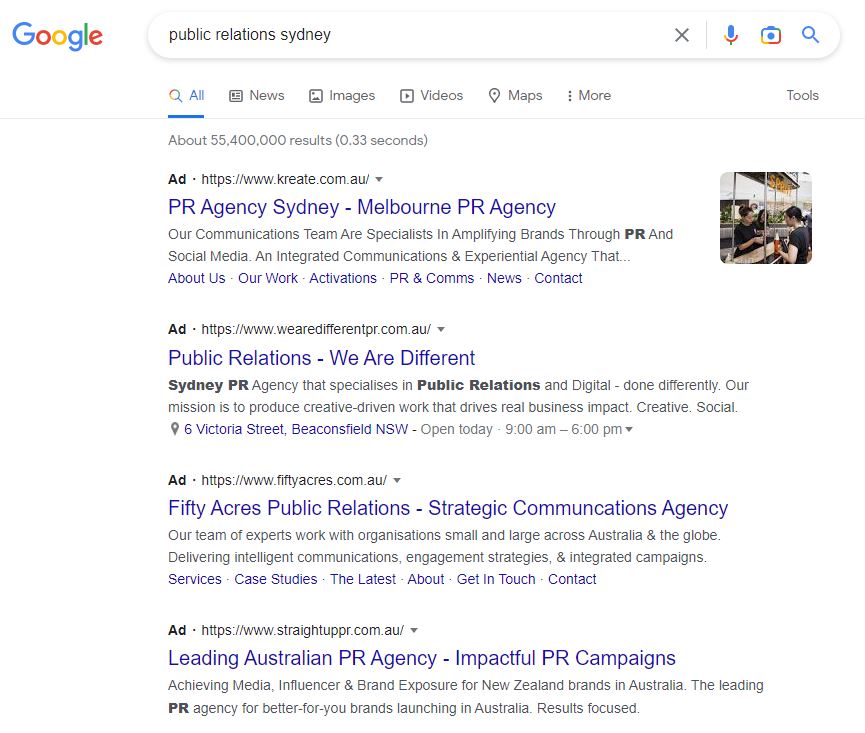
This shows how large the channel is and how useful it can be to use if your budget allows it.
Take the time to do your research to ensure your money is well spent. Some keywords and phrases are more popular than others = much more competition.
If you can find less popular, (but still relevant) keywords you may find you achieve a better ROI.
Social & Display Ads
Google Ads are one way of appearing on SERPs. Then there are social and display ads.
These are the ads you see when scrolling through Facebook or YouTube, for example.
These ads get your brand in front of more passive buyers. Those that are online but maybe aren’t searching or aware of a problem/need.
There are some pretty interesting stats that show how big social media advertising has become:
- Ad spending on social media has reached over $173 billion in 2022.
- 49% of internet users said they are likely to purchase from brands they see advertised on social media
- 72% of B2B marketers who use paid marketing channels online use social media as a marketing medium.
Display Ads are set up using Google Ads and appear on third-party sites such as YouTube or news sites.
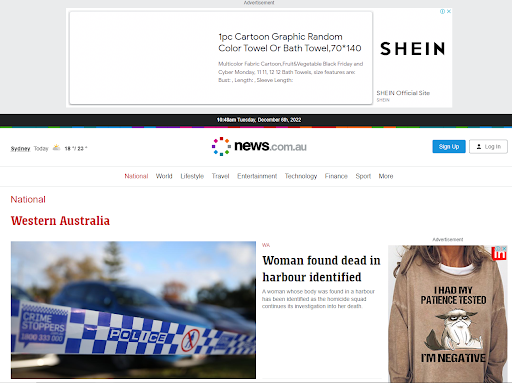
You can use both Social and Display Ads for retargeting campaigns.
For example, you can set your ads to retarget users who have visited your website before. Or you can retarget existing/past clients or those on your database.
It gives you the ability to stay relevant to warm leads or nurture customers to encourage repeat purchases.
Offline Advertising
The majority of people these days head online when looking for information. Whether it’s information on a brand, product, or service, you can usually find it online.
This can make it tempting to ignore more traditional marketing methods (offline advertising). But offline advertising still has its place.
Some examples of offline advertising are:
- Billboards
- TV/Radio ads
- Print ads (newspapers, magazines)
- Promotional Material
- Sponsorship
To work out which methods may work for your brand, you need to pay close attention to your target audience.
Offline advertising will be better suited for specific behaviours and attitudes.
For example, if you’re targeting a localised area then billboards and radio ads would be great.
Or, if you’re targeting the Silent Generation (who aren’t as tech-savvy), digital marketing efforts may completely miss the mark.
The one downside to offline advertising is the ability to track and measure results.
Most digital advertising provides detailed, real-time analytics.
You can use these to review performance and alter ads straight away. Offline advertising methods don’t tend to have this real-time data. This makes it hard to determine how many people:
- Saw your ad
- Your ad influences
- Acted on your ad
Content Marketing
This is the process of creating and distributing valuable, relevant, and consistent content.
It’s a way of promoting and raising awareness of your brand in an authentic and engaging way.
And, in turn, you’re able to encourage potential customers to your website and to get in touch.
Anyone can produce and provide content. Especially when the internet makes it so easy to distribute.
But in order for it to be successful and provide an ROI for your business, you need to think strategically.
There’s no point in spending your valuable time creating blogs, posts, and other content to tick a box.
61% of consumers say they prefer and are more likely to buy from a company that provides custom content.
So that in itself confirms why a content marketing strategy is important.
With a successful content marketing strategy you’re able to:
- Build brand awareness
- Educate your audiences
- Build trust and credibility
- Increase customer loyalty
- Generate leads and sales
To create a content marketing strategy, you need to be aware of the buyers’ journey.
Then try to get into the minds of your target audience.
What they need and want is going to differ based on what part of the journey they’re at. And where they’re going to find this information will also differ.
We’ve created an in-depth guide to content marketing that will help you create a content marketing strategy.
Email Marketing
Email marketing, as described by Mailchimp, is:
“a direct form of marketing that uses email to promote your products or services”.
It is a cost-effective way of promoting your brand and getting your message out to a large number of people in one go.
When used as part of your content strategy, email marketing provides many benefits.
Most marketers would say this is one traction channel that all companies should use.
- Generate leads
- Nurture your audience
- Build brand awareness and loyalty
- Keep your audience engaged
There are 4 types of emails, each with different purposes:
Welcome Emails
Sent to those who have recently signed up or purchased. Are a great way of introducing them to your brand, products, and services
Newsletters
Emails are sent to your database highlighting new products, blogs, or updates.
They tend to include Call to Actions directing the reader to your website or other links.
Lead Nurturing Emails
These are sent to specific audiences, usually with the use of automated campaigns.
You can provide tailored, unique content in the hope of converting to a sale.
Confirmation Emails
Sent to someone after they have taken a specific action.
Examples are signing up to your newsletter or purchasing from you.
They are an easy way to confirm the action and often include further offers or information.
- Extremely cost-effective
- Everyone on your mailing list has chosen to be there
- Analytics to decipher what works and what doesn’t
- Tailor emails to specific groups using segmentation
- Utilise automation functionality to save time
Engineering as Marketing
The majority of us have benefited from engineering as marketing at some point. Gabriel Weinberg and Justine Mares – authors of “Traction – A Startup Guide to Getting Customers”, define it as:
“Using engineering time to create useful tools like calculators, widgets, and educational microsites to get your company in front of potential customers. These tools then generate leads and expand your customer base”.
One example to show you engineering as marketing in action is Turo’s Carculator.
Turo is the world’s largest car-sharing marketplace (for the US, Canada, and the UK).
You can book any car you want, wherever you want it, from a vibrant community of trusted hosts.
Their ‘Carculator’ makes it super easy to find a vehicle to rent, often cheaper than a rental car agency.
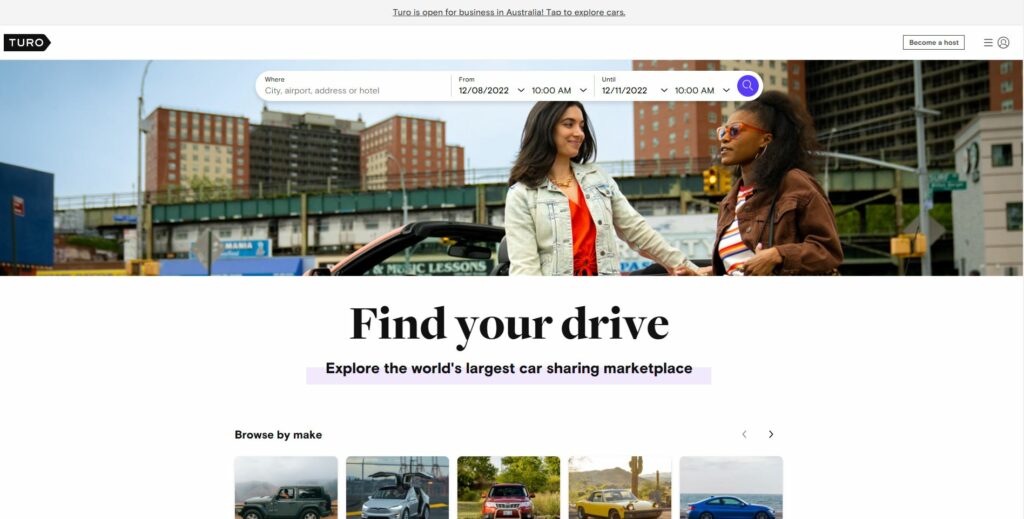
Compared to other methods, engineering as marketing can be quite hard.
You don’t need a big budget for the likes of email marketing, social media, and content marketing.
And most companies have the ability to do this in-house.
Whereas creating a marketing tool can be a bit harder as it is often expensive and complicated to build.
But, the benefits can make it well worth the time and effort you put in. When done right, you’ll:
- Raise your brand profile
- Build credibility and trust with potential customers
- Boost SEO
- Generate leads.
Remember, the key to a successful engineering marketing campaign is:
- Offer a tool that compliments your product/service
- Provide real value to the user
- Provide the tool at little or, preferably, at no cost.
Business Development
Business development is where you create partnerships and agreements with other businesses.
These partnerships are mutually beneficial, leveraging each other’s audiences to increase sales.
This is a great way to:
- Reach new audiences
- Increase sales in existing markets
- Increase your (and your audience’s) access to technology
- Increase capital
- Boost productivity
Both parties in the partnership collaborate to achieve a common goal.
To ensure there is a fair distribution of responsibilities, you each contribute ideas and resources. And, equally as important, you share the potential risks and rewards involved.
Sales
Direct sales strategies are perfect for audiences who need a more direct, personal approach.
For example, if your product is expensive or you have a lengthy conversion process.
The process involves:
- Generating new leads by cold calling, ‘door-knocking’, and following up enquiries
- Qualifying leads by determining how ready they are to buy
- Converting leads by nurturing, answering questions, and making the process simple.
Implementing a strategic sales funnel with documented processes and metrics is wise.
You can plan each stage of the funnel to provide a tailored and unique experience for each lead.
This makes it easy to assess, alter and scale your strategy as your company grows.
Affiliate Programs
This technique sees you rewarding or incentivizing third parties, in return for sales, leads, or traffic.
To put it simply, you reward those that help to increase your profit. This could be discounts, monetary rewards, or free products or stock.
The idea is that the ‘affiliate’, or member of your program, creates interest in your brand or offer.
They do this by sharing your website and directing their audience to learn more.
In return, you gain website traffic, leads, and best of all, sales.
Benefits you can gain from using affiliate programs could be:
- An increase in leads and sales gained as a result of inbound links
- Improvements in your SEO based on an increase in inbound links to your website. The more inbound links you have, (especially from reputable, popular sites) the better.
Members of your affiliate programs could be:
- Third-party websites such as blogs or industry-related websites
- Existing/current clients or customers
- Influencers
An example is Etsy and Amazon’s Affiliate Marketing Programs. If you have a website that you can use to refer to Etsy or Amazon, you can apply to join (noting there are strict criteria you must meet). You then earn a commission for every sale you generate from your website.
Existing Platforms
There are existing platforms out there with large audiences, ready and waiting. You can use these to your advantage.
Some examples are:
- YouTube
- Social media platforms – Facebook, Instagram, Pinterest, TikTok, etc
- Google and Android app stores
- Google Chrome extensions
Sometimes, these existing platforms have thousands, if not millions of users.
As you can imagine, this provides a massive opportunity for your business. When you understand your target audience, you can focus on platforms that they are likely to use.
One example of a company that used this channel is Evernote. By focusing on the Apple App store, they were able to generate millions of new customers.
Events
Hosting your own events – big or small, online or in person – is a popular way of building your brand. Of course, there is an element of cost that needs to fit within your budget. But for the right situations, the benefits make it a cost worth spending.
Events allow you to bring a much-desired personal experience to your audience. Whether it’s a small, intimate event or a large one, you can be right there, having important and valuable conversations.
Some examples that you could include in your annual plan are:
- Workshops on topics that cause frustration for your audience
- Conferences with guest speakers
- Social events such as hosting clients at sports games
- Trade breakfasts/lunches to launch a new product.
To ensure your event is a success, make sure the event is all about those attending.
The attendees want to walk away having learned or gained something of value. The last thing they want is to feel like all you did was try to get them to buy from you.
Speaking Engagements

Every month there are events all around you that are relevant to your industry.
You can attend these events, which provide a great opportunity to network.
Or, you could take it one step further and speak at these events.
If you’ve already established yourself as a thought leader in your industry, these opportunities are easier to find.
Your reputation will work for you, making it easy to pitch yourself. If you haven’t, look for upcoming events you can offer to speak at for little to no charge. Start small and build your way up from there to bigger and further afield events.
There are in-person events such as conferences, workshops, and networking.
And there are also online events like webinars. Both options provide highly-engaged audiences for you to get in front of.
But be wary. You don’t want to go speaking at every event you can get on a stage at.
This could be a waste of everyone’s time – yours, the organizers, and the audience’s. Find events that align with your brand values and goals. And make sure you provide value and opportunities to engage with the audience.
Community Building
Building a community around your brand is like building your own little team of mascots.
And when you build relationships with these people, they become passionate. Passionate about your brand, your products, and your services. And when there’s passion, demand tends to follow.
Your community doesn’t have to be your current customers and clients only.
It can extend to include:
- Past clients and their friends/family
- Brand partners
- Anyone interested in your industry
Those in your community become your brand evangelists.
They’ll be able to help you promote and share your brand far and wide
There’s now the ability to create online communities as well.
With social media platforms, you can create your own groups that users or prospects join. Or, you and your team can request to join other relevant, already-established groups.
There are many benefits to community building.
Some of the most important ones are:
- You’ll have brand evangelists who promote your brand for you
- Gain insights and feedback to further develop your brand and products
- Build relationships and loyalty
Targeting Blogs
In the expansive world that is the internet, there are some well-established and credible blog sites you can use to your advantage.
At the start of 2022, there were over 600 million blogs online. Out of those 600 million, there are bound to be lots of relevant blogs in your industry or niche you can tap into.
Targeting blogs involves reaching out to other blogging sites within your industry. What you’re looking to achieve is to get featured on these sites.
This in turn will generate more traffic for your website. And, you guessed it, generate leads and sales that you otherwise may not have got.
Being featured could look like this:
- Being a guest blogger on their website
- Having them reference your products, services, and website
The main aim is to build a relationship with the other blogger/creator.
The more relationships you can build (more specifically, the better the relationship) the more you can gain. These relationships can help you:
- To reach a new and wider audiences
- Build credibility and trust among readers
- Boost your SEO from the inbound links you generate
Trade Shows
A trade show is great for businesses and attendees alike.
Businesses can display, demonstrate and discuss their latest products and services. And attendees can learn about many different brands and companies, all in one place.
These events give you an opportunity to show off your products and services in person.
You are in control of what is being shown and the conversations that are happening.
A lot of businesses offer giveaways, promotions, and deals during these events. These act as an incentive to get those interested to take the first step of trying your product or service.
Those attending range from prospects and clients, wholesalers, potential partners, and the media. so as you can see, the opportunity to build relationships across the board is huge.
Of course, the more hype or intrigue you create at your stall, the more likely you are to generate interest.
The key is to make people want to find your stall and start a conversation with you.
As with all your marketing efforts, you need to provide something of value to those attending.
Take the time to plan out your time at the trade show;
- What is the main goal of attending?
- What are the key product/s or service/s you want to showcase?
- Whose attention matters the most? (customers/media/possible partners?)
- What promotional deals or incentives can you offer?
- How can you stand out from the other stallholders?
